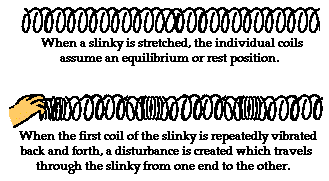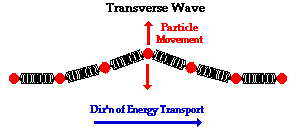This is where our dream begins;D
Failure is an event, Never a person!
3N1! Jiayou!!^^
So waves are everywhere. But what makes a wave a wave? What characteristics, properties, or behaviors are shared by all the phenomenon which we typically characterize as being a wave? How can waves be described in a manner that allows us to understand their basic nature and qualities?
A wave can be described as a disturbance that travels through a medium from one location to another location. Consider a slinky wave as an example of a wave. When the slinky is stretched from end to end and is held at rest, it assumes a natural position known as the equilibrium or rest position. The coils of the slinky naturally assume this position, spaced equally far apart. To introduce a wave into the slinky, the first particle is displaced or moved from its equilibrium or rest position. The particle might be moved upwards or downwards, forwards or backwards; but once moved, it is returned to its original equilibrium or rest position. The act of moving the first coil of the slinky in a given direction and then returning it to its equilibrium position creates a disturbance in the slinky. We can then observe this disturbance moving through the slinky from one end to the other. If the first coil of the slinky is given a single back-and-forth vibration, then we call the observed motion of the disturbance through the slinky a slinky pulse. A pulse is a single disturbance moving through a medium from one location to another location. However, if the first coil of the slinky is continuously and periodically vibrated in a back-and-forth manner, we would observe a repeating disturbance moving within the slinky which endures over some prolonged period of time. The repeating and periodic disturbance which moves through a medium from one location to another is referred to as a wave.


The above equation is known as the wave equation. It states the mathematical relationship between the speed (v) of a wave and its wavelength (![]() ) and frequency (f). Using the symbols v,
) and frequency (f). Using the symbols v, ![]() , and f, the equation can be rewritten as
, and f, the equation can be rewritten as
A transverse wave is a wave in which particles of the medium move in a direction perpendicular to the direction which the wave moves. Suppose that a slinky is stretched out in a horizontal direction across the classroom and that a pulse is introduced into the slinky on the left end by vibrating the first coil up and down. Energy will begin to be transported through the slinky from left to right. As the energy is transported from left to right, the individual coils of the medium will be displaced upwards and downwards. In this case, the particles of the medium move perpendicular to the direction which the pulse moves. This type of wave is a transverse wave. Transverse waves are always characterized by particle motion being perpendicular to wave motion.
